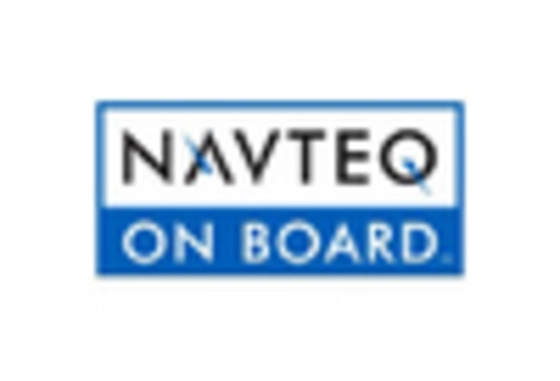The Automotive Digital Mapping Market is currently characterized by a dynamic competitive landscape, driven by rapid technological advancements and increasing demand for enhanced navigation solutions. Key players such as HERE Technologies (NL), Google (US), and TomTom (NL) are at the forefront, each adopting distinct strategies to solidify their market positions. HERE Technologies (NL) focuses on partnerships with automotive manufacturers to integrate its mapping solutions into vehicles, thereby enhancing user experience and driving adoption. Google (US), leveraging its extensive data capabilities, emphasizes AI-driven mapping solutions that provide real-time updates and predictive analytics, while TomTom (NL) continues to innovate in traffic data and routing algorithms, positioning itself as a leader in real-time navigation services. Collectively, these strategies contribute to a competitive environment that is increasingly reliant on technological innovation and strategic partnerships.
In terms of business tactics, companies are increasingly localizing their operations to better serve regional markets and optimize supply chains. The Automotive Digital Mapping Market appears moderately fragmented, with several players vying for market share. This fragmentation is indicative of a landscape where innovation and technological prowess are paramount, allowing key players to exert considerable influence over market dynamics. The collective actions of these companies not only shape their individual trajectories but also define the overall competitive structure of the market.
In August 2025, HERE Technologies (NL) announced a strategic partnership with a leading electric vehicle manufacturer to develop advanced mapping solutions tailored for autonomous driving. This collaboration is significant as it underscores HERE's commitment to enhancing its offerings in the rapidly evolving EV sector, potentially positioning it as a key player in the future of autonomous navigation. The integration of HERE's mapping technology into electric vehicles could lead to improved route optimization and energy efficiency, thereby enhancing the overall driving experience.
In September 2025, Google (US) unveiled a new feature within its mapping platform that utilizes machine learning to predict traffic patterns and suggest alternative routes. This development is crucial as it not only enhances user experience but also demonstrates Google's ongoing investment in AI technologies. By providing users with more accurate and timely information, Google strengthens its competitive edge in the digital mapping space, potentially attracting a larger user base and increasing engagement with its services.
In July 2025, TomTom (NL) launched a new suite of APIs designed for developers to integrate real-time traffic data into their applications. This move is indicative of TomTom's strategy to expand its ecosystem and foster innovation among third-party developers. By enabling easier access to its data, TomTom may enhance its market presence and create new revenue streams, thereby reinforcing its position in the competitive landscape.
As of October 2025, the Automotive Digital Mapping Market is witnessing trends that emphasize digitalization, sustainability, and the integration of artificial intelligence. Strategic alliances are increasingly shaping the competitive landscape, as companies recognize the value of collaboration in driving innovation. Looking ahead, it is likely that competitive differentiation will evolve, shifting from traditional price-based competition to a focus on technological innovation, reliability of supply chains, and the ability to deliver superior user experiences. This transition may redefine how companies compete, with an emphasis on creating value through advanced technologies and strategic partnerships.


















Leave a Comment